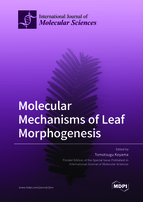Molecular Mechanisms of Leaf Morphogenesis
A special issue of International Journal of Molecular Sciences (ISSN 1422-0067). This special issue belongs to the section "Molecular Plant Sciences".
Deadline for manuscript submissions: closed (31 May 2020) | Viewed by 46968
Special Issue Editor
Interests: gene regulation; leaf development; senscence; transcription factor; transgenic plant
Special Issues, Collections and Topics in MDPI journals
Special Issue Information
Dear Colleagues,
Leaf morphology is obviously determined in a plant. By contrast, its morphology is often changeable when the plant copes with various environmental changes. We can speculate that leaf morphogenesis is based on the regulatory mechanisms with remarkable robustness and flexibility. Recent research has increasingly investigated the regulatory network of leaf morphogenesis and revealed some important regulators functioning in the leaf development but not obtained its full view of the molecular mechanisms of leaf morphogenesis.
To update our understanding of the leaf morphogenesis, this Special Issue will focus on the regulation of genes, proteins, hormones, and other metabolites for leaf morphogenesis in various plant species. It will further provide important insights in biochemical, developmental, and physiological events operating during morphogenesis. Emphasis will also be placed on the perspective views of how these molecular mechanisms contribute to the survival of plants and are applicable to improve plant traits.
Dr. Tomotsugu Koyama
Guest Editor
Manuscript Submission Information
Manuscripts should be submitted online at www.mdpi.com by registering and logging in to this website. Once you are registered, click here to go to the submission form. Manuscripts can be submitted until the deadline. All submissions that pass pre-check are peer-reviewed. Accepted papers will be published continuously in the journal (as soon as accepted) and will be listed together on the special issue website. Research articles, review articles as well as short communications are invited. For planned papers, a title and short abstract (about 100 words) can be sent to the Editorial Office for announcement on this website.
Submitted manuscripts should not have been published previously, nor be under consideration for publication elsewhere (except conference proceedings papers). All manuscripts are thoroughly refereed through a single-blind peer-review process. A guide for authors and other relevant information for submission of manuscripts is available on the Instructions for Authors page. International Journal of Molecular Sciences is an international peer-reviewed open access semimonthly journal published by MDPI.
Please visit the Instructions for Authors page before submitting a manuscript. There is an Article Processing Charge (APC) for publication in this open access journal. For details about the APC please see here. Submitted papers should be well formatted and use good English. Authors may use MDPI's English editing service prior to publication or during author revisions.
Keywords
- genes
- leaf morphogenesis
- metabolites
- plant hormones
- proteins
- regulation







